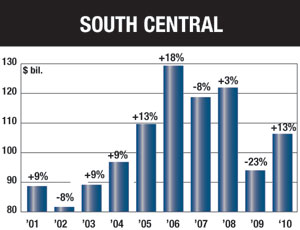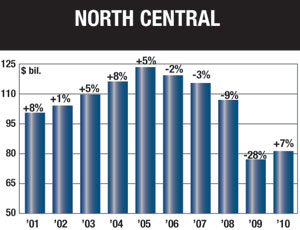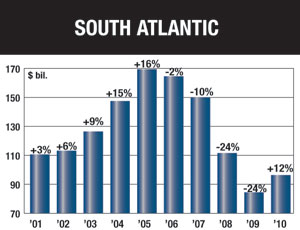...General Contractors of America in Arlington, Va.
“New neighborhoods being built would create demand for local retail,” he says. “It would be modest amounts. I wouldn’t expect any big shopping center construction.”



The drop in demand for consumer goods hit the manufacturing sector hard. Murray says that capacity utilization rates plummeted from 78.8% in December 2007 to 65.1% in June 2009, curtailing the need for new space. Murray sees a 14% drop in 2010 to $9.4 billion as capacity issues continue to hamper the sector.
Publicly funded projects represent a wild card for many analysts. Simonson says the impact of cautious consumer spending, high unemployment and drops in home values will be fully realized as tax revenues suffer in 2010.
“State and local budgets are continuing to shrink as tax receipts fall short,” and many government agencies reduced their budget projections in the second half of 2009, Simonson says.
Education is also suffering. Murray says that K-12 construction is likely to feel the pinch of lower property taxes, and higher-education projects are challenged to find funds because endowments dropped 20% in late 2008. McGraw-Hill Construction estimates that education buildings dropped 23% to 172 million sq ft in 2009 and expects the sector to continue its downward path in 2010 with 158 million sq ft of new starts.
Federally funded projects are on better footing. Funding from the American Recovery and Reinvestment Act boosted highway starts in ‘09. Total contracts by value for highways and bridges rose nearly $4.4 billion in 2009 to $57.3 billion.
And much of the stimulus has yet to hit the street. William R. Buechner, vice president of economics and research for the American Road & Transportation Builders Association in Washington, D.C., says stimulus could help total spending rise an additional $6 billion in 2010.
“Everybody agrees that the strongest impact will occur in 2010,” he says.
Buechner adds that state and local budget issues could impact highway and bridge spending in 2010. ARTBA estimates that 19 states are planning to cut highway investment next year.
“That’s a black box in terms of what the impact will be,” he says.
While a new federal highway bill remains on the horizon, many analysts expect the regular federal highway program to remain at current funding levels. With highway program funding flat and more stimulus yet to come, Murray forecasts a 13% rise to $64.7 billion in total starts.
In 2009, McGraw-Hill Construction estimates that mass transit starts jumped 29% to $5 billion, and another 18% rise to $5.9 billion is expected in 2010.
The prospect of billions of dollars for high-speed rail projects could also fuel added work in the coming years, Murray says.
Stimulus funds could help buoy institutional building construction in 2010. After a 23% drop in square footage in 2009, McGraw-Hill Construction forecasts that the sector will flatten out with a drop of 2%. Public buildings got a big boost from the ARRA in 2009 and will reap many of those benefits in 2010. Starts in the sector are expected to rise 8% to 51 million sq ft—on par with the 2007 peak.
Health-care projects took a big hit in 2009 in light of the tight credit market, but they may be on the road to recovery. McGraw-Hill Construction estimates suggest the sector dropped 36% in 2009 to an estimated 70 million sq ft of new space. That sector is expected to see 72 million sq ft of new starts in 2010.
Simonson says he’s “a bit more optimistic on health-care spending” going into 2010.
“Now that the stock markets have rallied and the bond markets have opened, that will enable health-care systems to resume their multiyear plans,” he says.
Simonson says that contractors will be particularly vulnerable in 2010 as most nonresidential sectors continue to suffer and existing work comes to completion.
“I think 2010 will be an even more difficult year for most nonresidential contractors than 2009,” he adds. “A number of them still had backlogs that they worked through in 2009, but very few have enough to keep them busy through 2010. Only a minority is going to be winning stimulus projects. It will be a tough year.”




Post a comment to this article
Report Abusive Comment